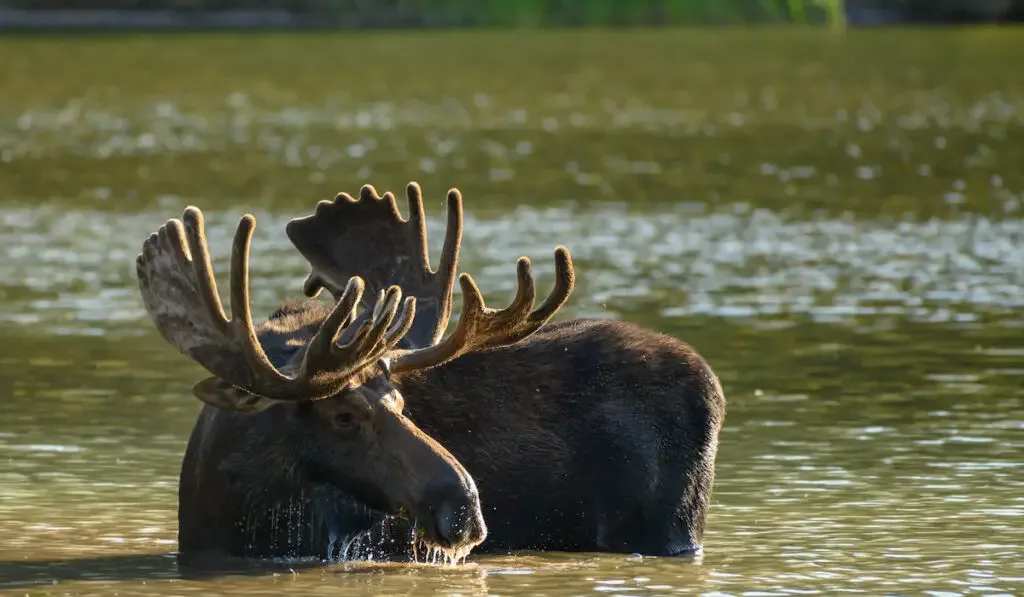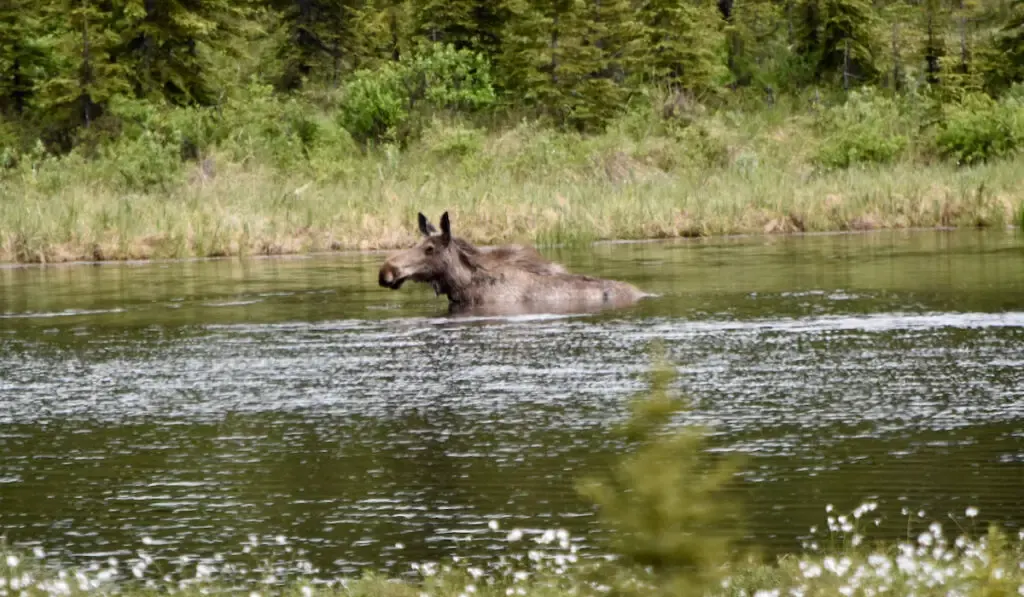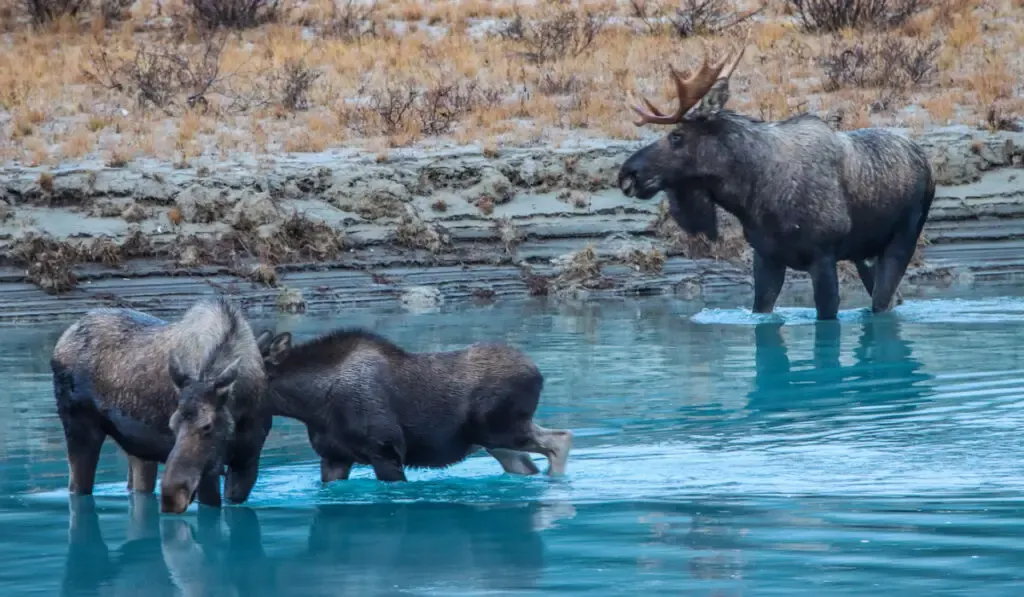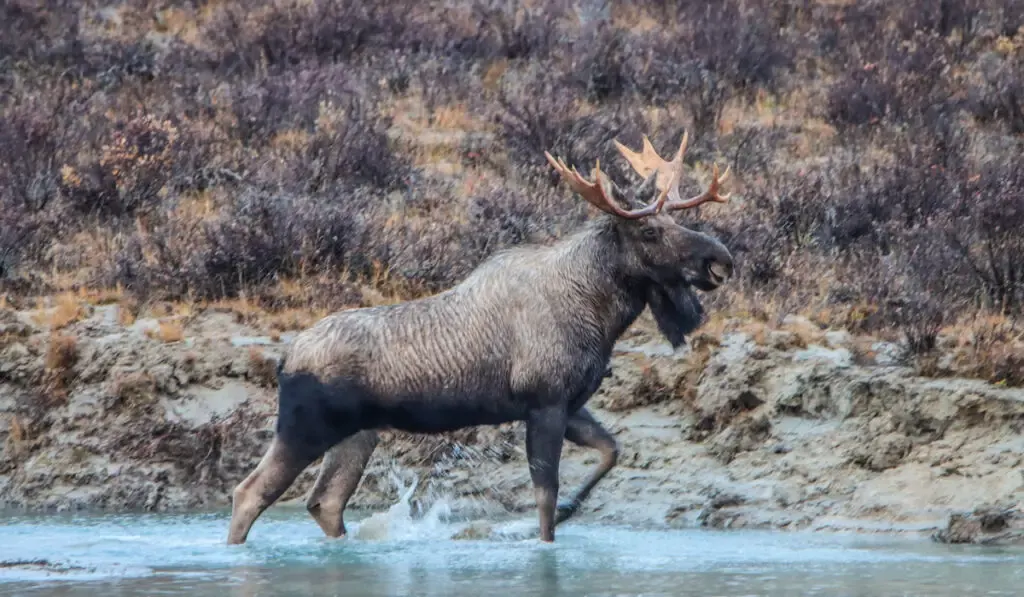When you think of animals that can swim, we are pretty sure a moose is not the first one that pops into your head. But then, can moose actually swim? Find out below.
Can moose swim?
Moose can swim, and interestingly, they can swim as fast as the fastest human swimmers.
Beyond just swimming, moose can dive underwater, and they do so for various reasons. They dive underwater to feed, take refuge, or cool themselves off.
Check out the rest of this article below as we give a detailed account of the moose’s ability to swim. We talk about the reasons moose swim, how fast they swim, whether they affect aquatic life or not, and more.

Table of Contents
Can Moose Swim?
You would think with their staggering size and bulky frame, that swimming would be out of the question for moose. But this is not the case.
Moose can swim, and in fact, they can swim as fast or faster than the average Olympic swimmer. Amongst hoofed animals, moose are one of the fastest swimmers, with a top swimming speed of around 6 mph.
Of course, being terrestrial animals, moose are nimbler on land. They hit top speeds of 35 mph over short distances – almost 6 times faster than their swimming speed. Still, for animals that can weigh up to 1800 pounds, swimming at 6 mph is impressive.
Beyond just swimming, moose can dive down into the water. While moose prefer the shallows, they can dive as deep as 16 feet when they want to.
Considering that moose do not have fins, webbed feet, or gills, you may be wondering how they survive when they dive. Well, moose have flexible nostrils, which shut out water when they dive. With their nostrils closed, moose can stay underwater for around 30 to 50 seconds.
Moose swim in water with their wide hooves and sturdy legs, and their dense fur keeps them insulated. Besides insulation, their coat also serves as a lifejacket as it traps air bubbles, making flotation easier.

Reasons Why Moose Swim
For Food
Moose live in the northern regions of the world, where inland plants are scarce. So, they have had to evolve to also thrive on aquatic plants. Their adaptation to the scarcity pushes them to swim and dive for aquatic vegetation.
In these northern parts of the world, the rivers, lakes, and other wetlands stay frozen for a considerable part of the year. But in summer, when the ice melts, the moose move to rivers and wetlands. They spend most of their time in these environments and feed primarily on aquatic vegetation throughout summer.
Moose can dive as deep as 16 feet to get aquatic plants in water.
On average, they consume up to 55 pounds of vegetation per day.
When moose go underwater for plants, they do not have to swim to the surface before chewing and swallowing the plant. This is possible, thanks to the bulbous form of their nose.
To Cool Themselves
Moose are pretty sensitive to heat; summer temperatures as low as 60℉ can leave them stressed. So, to mitigate the effect of the heat, they get in the water to cool their bodies.
To Migrate
In times of scarcity, moose may migrate from one area to another. Sometimes for them to migrate, they must swim over long distances.
To Help Improve Their Health
Swimming can actually benefit a moose’s health in more than one way. During the warmer seasons, moose may get infested with bugs and ticks. But when they get in the water, some of those ticks and bugs wash off, resolving the infestation.
Apart from that, swimming eases the pressure on the joints and bones of moose through buoyancy.
To Take Cover
In some cases, moose swim to escape predators. Moose swim better than some of their terrestrial predators.
For instance, wolves have a top swimming speed of around 5 mph, but moose can swim at 6 mph. So, they can escape wolves in the water. Also, moose can swim in troubled waters that would sweep wolves away.
Mountain lions are another terrestrial predator of moose. While they can swim, they would prefer not to get wet. So, if a moose gets in the water, mountain lions may just let them go.

Do Moose Affect Aquatic Life?
One of many reasons moose go into the water is to feed on aquatic vegetation. So, moose do affect aquatic life.
While moose feed on aquatic plants, their effect on marine life may not necessarily be negative. Many aquatic plant species can tolerate the removal of around 50% of their annual growth. So unless moose graze intensely on the aquatic plants in an area, aquatic plant life should be okay.
Still, moose prefer aquatic plants to land plants because marine plants are more nutritious. So, the odds of them overgrazing are not low.
Beyond eating aquatic plants, moose contribute to marine life by providing nitrogen through urination and defecation. The nitrogen they release helps fertilize aquatic plants and promote growth.
Can Moose Calves Swim?
Moose calves can swim just like adults. They typically start swimming within some days after their birth. However, they stay close to their mothers when they swim because of predators.

Are Moose Safe in Water?
Moose are not totally safe in the water. While they sometimes take cover from terrestrial predators by going into the water, they are still prone to attacks from aquatic predators.
For one, sharks may attack moose in the water. Although, if the moose is lucky, the shark may just choke on its fur.
Besides sharks, there are reports that killer whales (orcas) prey on moose in the water. So, water is not really a haven for moose.
Final Thoughts
Moose can swim – they can even dive as deep as 16 feet. They typically swim in summer in search of aquatic vegetation.
But beyond that, they may also swim to protect themselves, cool themselves, migrate, or improve their health.
Resources
- https://www.livestrong.com/article/456880-the-speed-of-human-swimming/
- https://factpros.com/can-moose-swim-15-facts-about-mooses-swimming-ability/
- https://www.nationalgeographic.com/animals/mammals/facts/moose
- https://www.tetonscience.org/can-moose-really-dive/
- https://pubs.cif-ifc.org/doi/pdf/10.5558/tfc64238-3
- https://rangerplanet.com/do-wolves-swim-which-ones-how-why-how-far-guide
- https://www.wildrepublic.com/product/mountain-lion
- http://davidclaytonthomas.com/gmxzw/7e630b-orca-attacks-moose
